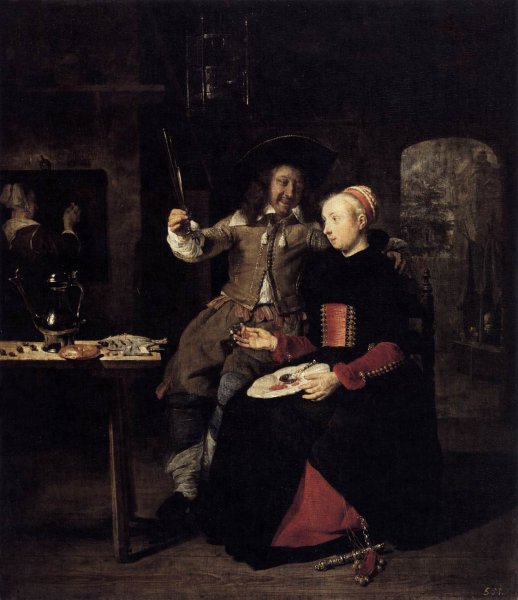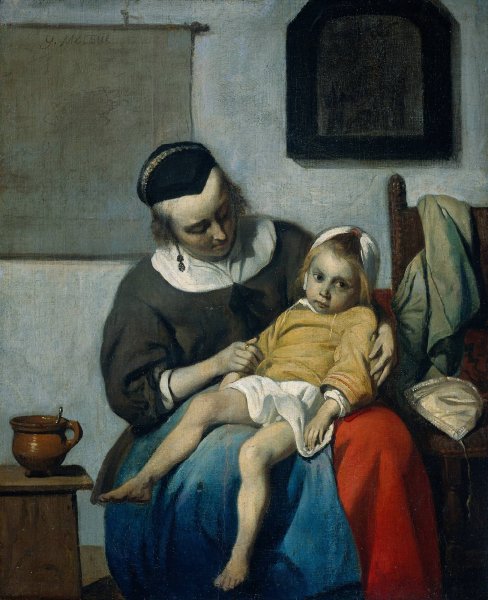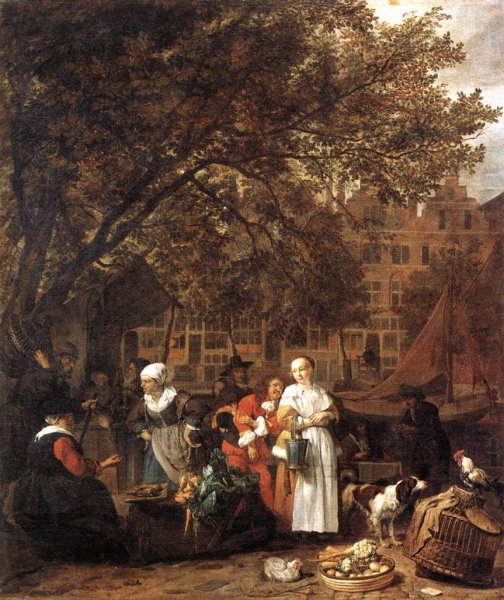Gabriel Metsu Biography In Details
Life

Gabriel Metsu (Leiden - buried Oct 24, 1667, Amsterdam), Dutch painter, was the son of the Flemish painter Jacques Metsu (c.1588-1629), who lived most of his days at Leiden, where he was three times married. The last of these marriages was celebrated in 1625, and Jacomijntje Garniers, herself the widow of a painter with already three children, gave birth to Gabriel.
According to Houbraken Metsu was taught by Gerard Dou, though his early works do not lend colour to this assertion. He was influenced by painters in Leiden like Jan Steen and Jan Lievens, later by Frans van Mieris the Elder.
Metsu was registered among the first members of the painters' corporation at Leiden; and the books of the guild also tell us that he remained a member in 1649. In 1650 he ceased to subscribe, and works bearing his name and the date of 1653 support the belief that he had moved to Amsterdam. In Leiden it was told Metsu left a brothel at six in the morning and took a prostitute to the Academia. Before he moved to Amsterdam Metsu was trained in Utrecht by Jan Baptist Weenix and Nicolaus Knüpfer.
In Amsterdam Metsu lived in an alley on Prinsengracht, where he kept chickens. He got into an argument with a neighbor and moved to a house on the canalside, where a daily vegetable market was held. In 1658 he married Isabella de Wolff, whose father was a potter, her mother a painter. (Pieter de Grebber, a religious painter from Haarlem was her brother). The Speed Art Museum has a portrait of the couple.
Around the year 1661 Metsu won the protection of the Amsterdam cloth merchant Jan J. Hinlopen and painted his family more than once in a fashionable surrounding. After Metsu died his widow left for Enkhuizen, to live with her mother.
Works

One of his earliest pictures is the "Lazarus" at the Strassburg Museum, painted under the influence of Jan Steen. In 1653 under the influence of Rembrandt he painted "Woman taken in Adultery," a large picture which is now in the Louvre. To the same period belong the "Departure of Hagar," formerly in the Thore collection, and the "Widow's Mite" at the Schwerin Gallery. But he probably observed that sacred art was ill suited to his temper, or he found the field too strongly occupied, and turned to other subjects for which he was better fitted. That at one time he was deeply impressed by the vivacity and bold technique of Frans Hals can be gathered from Lord Lonsdale's picture of "Women at a Fishmonger's Shop."
What Metsu undertook and carried out from the first with surprising success was the low life of the market and tavern, contrasted, with wonderful versatility, by incidents of high life and the drawing-room. In no single instance do the artistic lessons of Rembrandt appear to have been lost upon him. The same principles of light and shade which had marked his schoolwork in the "Woman taken in Adultery" were applied to subjects of quite a different kind. A group in a drawing-room, a series of groups in the market-place, or a single figure in the gloom of a tavern or parlour, was treated with the utmost felicity by fit concentration and gradation of light, a warm flush of tone pervading every part, and, with that, the study of texture in stuffs was carried as far as it had been by Ter Borch or Gerard Dou, if not with the finish or the brio of De Hooch.
Market-place of Amsterdam

One of the best pictures of Metsu's manhood is the "Market-place of Amsterdam," at the Louvre, respecting which it is difficult to distribute praise in fair proportions, so excellent are the various parts, the characteristic movement and action of the dramatis personae, the selection of faces, the expression and the gesture, and the texture of the things depicted. Equally fine, though earlier, are the "Sportsman" (dated 1661) and the "Tavern" (also 1661) at the Hague and Dresden Museums, and the "Game-Dealer's Shop," also at Dresden, with the painter's signature and 1662.
Among the five examples of the painter in the Wallace Collection, are "The Tabby Cat," and "The Sleeping Sportsman," which cost Lord Hertford £ 3000, is an admirable example technically considered. Among his finest representations of home life are the "Repast" at the Hermitage in St Petersburg; the "Mother nursing her Sick Child" in the Rijksmuseum in Amsterdam; the "Amateur Musicians" at the Hague Gallery; the "Duet" and the "Music Lesson" at the National Gallery, London, and many more examples at nearly all the leading European galleries. Five of his painting are in Dresden, collected by August the Strong.(From wikipedia)




